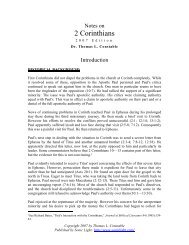1 Samuel - Odessa, Missouri Community of Christ
1 Samuel - Odessa, Missouri Community of Christ
1 Samuel - Odessa, Missouri Community of Christ
Create successful ePaper yourself
Turn your PDF publications into a flip-book with our unique Google optimized e-Paper software.
56 Dr. Constable's Notes on 1 <strong>Samuel</strong> 2007 EditionAmalekites plus their animals completely (v. 3; cf. Deut. 7:2-6; 12:2-3; 20:16-18). Godhad commanded Joshua to do the same to Jericho; every breathing thing was to die (Josh.6:17-21; cf. Deut. 20:16-18). Saul was now to put the Amalekites under the ban (Heb.herem). 163 God had plainly commanded this destruction <strong>of</strong> the Amalekites through Moses(Exod. 17:16; Deut. 25:17-19; cf. Num. 24:20; Gen. 12:3). Thus there was no questionwhat the will <strong>of</strong> God involved. The phrase "utterly destroy" (Heb. heherim) occurs seventimes in this account (vv. 3, 8, 9 [twice], 15, 18, 20) showing that God's will was clearand that Saul's disobedience was not an oversight."The agent <strong>of</strong> divine judgment can be impersonal (e.g., the Flood or thedestruction <strong>of</strong> Sodom and Gomorrah) or personal (as here), and in hissovereign purpose God <strong>of</strong>ten permits entire families or nations to bedestroyed if their corporate representatives are willfully and incorrigiblywicked (cf. Josh 7:1, 10-13, 24-26)." 164The Amalekites (v. 6) were descendants <strong>of</strong> Esau (Gen. 36:12) whereas the Kenites tracedtheir ancestry from Midian, one <strong>of</strong> Abraham's sons by Keturah (Gen. 25:2). The Keniteshad been friendly to Israel (Exod. 18:9, 10, 19; Num. 10:29-32) whereas the Amalekiteshad not. There may have been a treaty between the Israelites and the Kenites. 165Saul's criterion for what he put to death was not part <strong>of</strong> God's command but his ownjudgment (v. 9). Again, Saul's defective view <strong>of</strong> his role under Yahweh's sovereign rule isobvious. God had earlier revealed through Balaam that Israel's king "shall be higher thanAgag" (Num. 24:7). As Achan had done, Saul misused some <strong>of</strong> what God had devoted toanother purpose. Clearly Saul set his will against the orders <strong>of</strong> his Commander; he was"not willing" to destroy everything that breathed (v. 9). His obedience was selective andpartial.The phrase "the word <strong>of</strong> the Lord came to" occurs only three times in 1 and 2 <strong>Samuel</strong> (v.10; cf. 2 Sam. 7:4; 24:11). In all cases it refers to an important message <strong>of</strong> judgment thatGod sent Israel's king through a prophet. God regretted that He had made Saul king (v.11) because <strong>of</strong> Saul's actions, not because God felt He had made a mistake in callingSaul. Saul's failure to follow God faithfully also broke <strong>Samuel</strong>'s heart. The disobedience<strong>of</strong> leaders always grieves the hearts <strong>of</strong> God's faithful servants. <strong>Samuel</strong> foresaw theconsequences <strong>of</strong> Saul's actions. The village <strong>of</strong> Carmel (lit. vineyard) stood about 8 milessouth and a little east <strong>of</strong> Hebron. The monument Saul set up honored himself, not Godwho gave him the victory. When Moses defeated the Amalekites, he built an altar (Exod.17:15-16); but when Saul defeated them, he erected a stele (cf. 2 Sam. 18:18).163 This practice was not unique to Israel; the Moabites and presumably other ancient Near Eastern nationsalso put cities and groups <strong>of</strong> people under the ban. See Gordon, pp. 143, 147-48.164 Youngblood, p. 673. On the problem <strong>of</strong> God's goodness and His severe treatment <strong>of</strong> sinners, and eventheir animals, in the Old Testament, see Peter C. Craigie, The Problem <strong>of</strong> War in the Old Testament; andJohn W. Wenham, The Enigma <strong>of</strong> Evil: Can We Believe in the Goodness <strong>of</strong> God?165 F. Charles Fensham, "Did a Treaty Between the Israelites and the Kenites Exist?" Bulletin <strong>of</strong> theAmerican Schools <strong>of</strong> Oriental Research 175 (October 1964):51-54.








